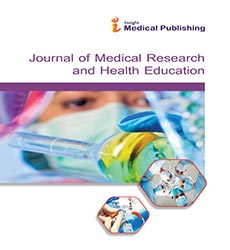Medical Simulation and Its Impact on Clinical Competence
Jessie Mathias*
Department of Biomedical Sciences, University of Milan, Via della Commenda 10, 20122 Milan, Italy
*Corresponding author:
Jessie Mathias,
Department of Clinical Sciences, University of Pavia, 27100 Pavia, Italy,
E-mail: Mathias.jess@unimi.it
Received date: February 03, 2025, Manuscript No. ipjmrhe-25-20729; Editor assigned date: February 05, 2025, PreQC No. ipjmrhe-25-20729 (PQ); Reviewed date: February 10, 25, QC No. ipjmrhe-25-20729; Revised date: February 17, 2025, Manuscript No. ipjmrhe-25-20729 (R); Published date: February 24, 2025, DOI: 10.36648/2393-8862.9.1.03
Citation: Mathias J (2025) Medical Simulation and Its Impact on Clinical Competence. J Med Res Health Educ Vol. 9 No.1:03
Introduction
Medical education has evolved significantly over the past decades, moving from traditional didactic teaching and apprenticeship models toward experiential, competency-based learning. One of the most transformative developments in modern medical education is the use of simulation. Medical simulation encompasses a wide range of tools and techniques, including high-fidelity mannequins, standardized patients, virtual reality platforms, task trainers and computer-based simulations, designed to replicate real clinical scenarios in a safe and controlled environment. The primary aim of simulation is to enhance clinical competence by allowing learners to practice technical skills, clinical reasoning, decision-making and interprofessional collaboration without putting patients at risk. With increasing complexity in healthcare, rising patient safety concerns and limited opportunities for hands-on training in real-world settings, medical simulation has become an essential component of medical education and professional development [1].
Description
Medical simulation addresses several critical domains of clinical competence, including knowledge acquisition, procedural skills, clinical reasoning, communication, teamwork and patient safety. High-fidelity simulation mannequins provide realistic anatomical, physiological and pathological responses, enabling learners to perform procedures such as airway management, cardiopulmonary resuscitation, central line placement and laparoscopic interventions. These simulations allow repetitive practice, immediate feedback and correction of errors, reinforcing skill acquisition and building confidence. Task trainers and part-task simulators focus on specific technical skills, offering targeted practice in procedures that require fine motor control and precision [2].
Standardized patients, or trained actors portraying medical conditions, are widely used to teach and assess clinical communication, history-taking, physical examination and patient counseling skills. This form of simulation emphasizes empathy, professionalism and patient-centered care, allowing learners to practice sensitive conversations such as breaking bad news or obtaining informed consent [1]. Objective evaluation during these encounters provides learners with constructive feedback, promoting reflective practice and continuous improvement. Virtual Reality (VR) and Augmented Reality (AR) simulations represent the forefront of medical training technology. VR platforms allow immersive, interactive learning experiences for surgical procedures, anatomy education and emergency response training. Trainees can navigate three-dimensional anatomical structures, perform simulated surgeries and experience complex scenarios such as mass casualty incidents or obstetric emergencies. AR enhances real-world practice by overlaying digital information onto physical environments, guiding learners through procedures or clinical decision pathways. These technologies facilitate the acquisition of both cognitive and psychomotor skills while providing safe opportunities for error-based learning [2].
Medical simulation is particularly effective in promoting interprofessional education and teamwork. Multidisciplinary simulation exercises replicate real-world clinical environments, where physicians, nurses, pharmacists and allied health professionals collaborate in patient care. These exercises foster communication, coordination, role clarity and situational awareness, which are essential for minimizing medical errors and improving patient outcomes. Crisis resource management simulations, derived from aviation safety principles, teach teams to prioritize tasks, allocate resources efficiently and manage high-stress situations. Studies have shown that interprofessional simulation improves team dynamics, reduces adverse events and enhances overall clinical performance.
The impact of simulation on clinical competence extends beyond skill acquisition. By allowing repeated practice in a low-risk environment, simulation enhances learnersâ?? confidence, critical thinking and decision-making abilities. It enables deliberate practice, where specific skills or scenarios are repeated until mastery is achieved and reinforcing long-term retention. Simulation also promotes reflective learning, as debriefing sessions following scenarios encourage learners to analyze their actions, identify errors, discuss alternatives and integrate feedback into future practice. These reflective practices are associated with improved clinical judgment, adaptability and patient safety awareness.
Conclusion
Medical simulation has transformed health professional education by providing realistic, safe and structured opportunities to develop clinical competence. Through high-fidelity mannequins, standardized patients, VR/AR platforms, task trainers and interdisciplinary exercises, simulation enhances procedural skills, clinical reasoning, decision-making, communication and teamwork. It allows deliberate practice, reflective learning and risk-free error correction, improving knowledge retention, confidence and patient safety.
Evidence demonstrates that simulation-based training translates into improved performance in real clinical settings and better patient outcomes. Despite challenges related to cost, faculty training and curriculum integration, simulation remains an essential component of competency-based medical education. As technology advances and accessibility improves, medical simulation will continue to play a pivotal role in preparing healthcare professionals who are skilled, confident and capable of delivering safe, effective and patient-centered care.Acknowledgement
None.
Conflict of Interest
None.
References
- Malik S, Roeder RG (2010) The metazoan Mediator co-activator complex as an integrative hub for transcriptional regulation. Nat Rev Genet 11: 761-772.
Google Scholar Cross Ref Indexed at
- Mochizuki K, Nishiyama A, Jang MK, Dey A, Ghosh A, et al. (2008) The bromodomain protein Brd4 stimulates G1 gene transcription and promotes progression to S phase. J Biol Chem 283: 9040-9048.
Open Access Journals
- Aquaculture & Veterinary Science
- Chemistry & Chemical Sciences
- Clinical Sciences
- Engineering
- General Science
- Genetics & Molecular Biology
- Health Care & Nursing
- Immunology & Microbiology
- Materials Science
- Mathematics & Physics
- Medical Sciences
- Neurology & Psychiatry
- Oncology & Cancer Science
- Pharmaceutical Sciences
